Siddhachakra
Siddhachakra is a popular yantra or mandala (mystical diagram) used for worship in Jainism.[1][2] It is also known as Navapada in the Svetambara tradition and Navadevta in the Digambara tradition. In the Svetambara tradition it is associated with the Namokar Mantra.[3][4][5][6] It is related to the legend of King Shripala and his wife Mayanasundari. It is depicted as a Kalasha with the core of a blossomed lotus representing Navapada in the centre surrounded by guarding deities on petals. It is used in some rituals.
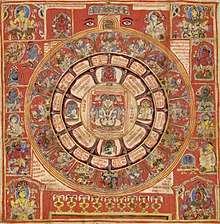
| Part of a series on |
| Jainism |
|---|
 |
|
Jain prayers |
|
Ethics |
|
Major sects |
|
Texts |
|
Festivals
|
|
|
Etymology
Siddha refers to a liberated soul, while chakra means wheel. It is believed that worshiping Siddhachakra results in freedom from the cycles of life within a universal 'wheel' known as nirvana.[2] It also means a 'circle of perfection'. Navapada means 'nine petals' in reference to the centre of the yantra, while Navadevta means 'nine deities'.[4][5] It is also described as a 'saint wheel'.[7]
History
The two major sects of Jainism, Svetambara and Digambara, differ in their concept of Siddhachakra. The first five deities, known as the Panch Parmeshthi (five supreme beings) are the same in both traditions while the other four are different. They were traditionally known as Navapada in the Svetambara tradition and Navadevta in the Digambara tradition.[8]
Svetambara
Siddhachakra most likely originally had only the Panch Parmesthi, Arihant in the center and the other four in petals in four different directions. It may have been inspired from Namaskara Valaya based on the Namokar Mantra as in some older Siddhachakra. The four last lines describing phalashruti (benefits) are depicted in addition to the petals at the four corners. They are described by Acharya Hemachandra in Yogashastra. He also noted that Vajraswami (BCE 57 – 57 CE) derived it from the lost Vidyanupravad parva text.[8]
It seems that the other four padas were added later. Acharya Dinkara (1411 CE) described Navapada in Nandyavrata Mandala. Nirvanakalika (c. 11th century) described it but replaced Tapa with Suchi-vidya.[8]
Ratnamandira Gani or Acharya Ratnashekhara wrote about the legend of Shripal in Siri-Sirivala-Kaha in Prakrit along with Siddhachakra Puja in 1372 or 1362 CE, the earliest known reference.[9] A later popular version called Shripal Rajano Ras was written in 1682 CE by Vinayvijay and Yashovijay.[2][8][9][10]
Legend
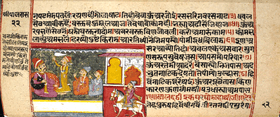
The legend takes place during the time of the twentieth Jain Tirthankara Munisuvrata, about 1.1 million years ago according to Jain traditions. There was a king named Singharth and a queen Kamalprabha of Champanagar. His brother Ajitsen captured Champanagar when he died. To save five-year-old Shripal from his uncle, Kamalprabha fled from the city and left him with a group of lepers while being chased by soldiers. Shripal was also infected by leprosy. He changed his name to Umar Rana and became the group's leader.[2][9][10][11]
Eventually he reached Ujjain where King Prajapal was ruling. Out of anger from being disrespected by his daughter, Mayanasundari, he married her to the leprous Shripal. They met a Jain monk, Munichandra, who advised them to do a ritual named Ayambil Oli which is dedicated to the central Navpada in Siddhachakra. It cured Shripal's leprosy along with that of 700 other lepers. Later he conquered Ujjain and Champanagar.[3][5][11][12][13]
Digambara
Navdevata was depicted as Pratishtha-vidhi-mandala in Pratishtha-tilaka by Nemichandra (c. 15th century). It was also described in Pratishtha-Sirodhara by Ashadhar, Jin-samhita by Indranandi (c. 10th century), and Paratishtha-Kalpa-Tippanam by Kumudchanra.
Jinasamhita by Ekasamdhi (c. 1250 CE) described it in detail, depicting it as similar to Brihad Siddhachakra.
Types
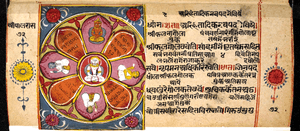
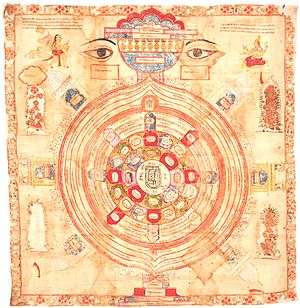
There are two types of Siddhachakra. The small types have only a central part depicting Nav pada which only includes Arihant, Siddha (liberated souls), Acharya (leaders), Upadhyaya (teachers) and Sadhu (monks) along with the other four. Large types includes all of the structures described below called Brihad Siddhachakra or Siddhachakra Mahayantra. Small types are found frequently in Jain temples and in carvings while larger ones are found in brass plate form or made of different lentils during rituals on special occasions.[1][2][6]
Structure
It is depicted as a Kalasha with an eye on both sides and a core made of a fully blossomed lotus. It has many circles of petals marking different concepts in Jainism.[5][6]
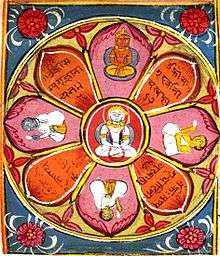
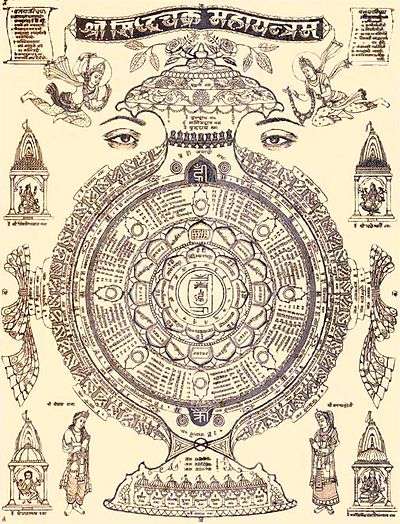
Kalasha
A Kalasha is depicted as a pot with a large base and a mouth generally covered with a lid or topped with a coronet of mango leaves and a coconut. It is decorated with clothes and ornaments in images. Two eyes are depicted around the Kalasha, symbolising right faith and right knowledge.[2][5][6]
At the neck of the Kalasha are nine small pots known as Nav Nidhi which describe nine kinds of wealth or treasures. Nine shrines dedicated to Navagraha are at the base of Kalasha which indicate nine 'cosmic influencers'.[2][3][5][6]
Lotus
At the core is a fully blossomed lotus with many circles of petals marking different concepts in Jainism. Navpada (Nine elements) is at the core surrounded by circles of petals called valaya. There is variation in the number of circles made by the petals in different images but generally there are ten circles.[3][5][6][14]
Navapada
Navapada is the core of the lotus.[15] Navapada includes five supreme beings having virtues, Guni or Panch Parmeshthi, and four right virtues, Gunas according to Svetambara tradition. Their attributes are described in 108 scriptures.[1][2][3][4][14] They are also illustrated in silver or copper plates for worship.[6][16] In the Digambara tradition, it has the same Panch Parmeshthi but the other four elements are different.[8]
| Navpada of Siddhachakra | ||||||
|---|---|---|---|---|---|---|
| No. | Svetambara | Digambara | Place | Description | Colour | Attributes |
| 1 | Arihant | centre | enlightened soul who teaches world the path of liberation | 12 | ||
| 2 | Siddha | Upper centre | liberated soul residing in Moksha | 8 | ||
| 3 | Acharya | Right | the preceptor, leader of Sangha (community) | 36 | ||
| 4 | Upadhyaya | Lower centre | a person with knowledge who teaches to others | 25 | ||
| 5 | Sadhu | Left | Jain monks and nuns | 27 | ||
| 6 | Darshan | Chaitya | Upper right | Right Faith/Jain Image | 67 | |
| 7 | Gyan | Chaityalaya | Lower right | Right Knowledge/Jain temple | 51 | |
| 8 | Charitra | Dharmachakra | Upper left | Right Conduct/Wheel of Dharma | 70 | |
| 9 | Tapa | Shruta | Lower left | Right Austerities/Jain scriptures | 50 | |
Valaya
Navapada is surrounded by circles of petals called valaya which describe various concepts and guarding deities as mantras.[5][6]
| Circle No. | Petal | Described concept | Notes | Details |
|---|---|---|---|---|
| 1 | Nucleus | Aryandrapad | Part of Navpada | Arihant of Navapada, many times as a mantra |
| 2 | Small circle | Vowels | in Sanskrit | Vowels and sounds |
| 3 | 8 petals | 8 padas | Part of Navpada | Other 8 members of Navapada |
| 4 | 16 petals | 49 basic sounds | in Sanskrit | Vowels and sounds |
| 5 | 8 sections | 48 labdhi | powers of higher souls | in group of 6 in each section |
| 6 | 8 sections | 8 Guru footprints | with mantra having names | 2 petals, each at two poles have sacred mantra: Hrim and Klim |
| 7 | 8 sections | 8 Goddesses | Jaya devi etc. | Guarding deities[3] |
| 8 | 16 petals | 16 Adhishthayak Dev | Principal deities | |
| 9 | 16 petals | 16 Vidya devi | Goddesses | |
| 10 | 48 petals | 48 Attendant deities | 24 Yaksha and 24 Yakshini |
Some have additional petals describing four vira (guarding deities) and ten Digpala (protectors of ten directions).[3]
Surroundings
The sun and moon are depicted on the right and left side of the Kalasha, respectively. There are four shrines with guarding deities in the four corners: Kshetrapal, Vimaleshwar, Chakreshvari, and Aprasiddha Siddha Chakradhisthanak. Sometimes King Shripal and Queen Mayanasundari are depicted on the sides of the Kalasha as based on a legend.[1][2][5][6][14]
Rituals
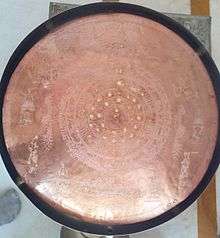
Navapada Aradhana and Ayambil Oli
Navapada Aradhana is associated with the Shripal-Mayanasundari legend.[13] Navapada Aradhana is performed by meditating on Navapada and doing an ayambil. In an ayambil, only one meal is eaten each day of plain food without any spices, sugar, salt, oil, butter, milk, vegetables or fruits. It is performed for nine days, twice a year. It is called Ayambil Oli. It falls in the months of Chaitra (March/April) and Ashwin (September/October) of the Jain calendar.[3][6][9][10][11][12][17] A procession of Siddhachakra is carried out in towns known as Jalayatra.[7]
Siddhachakra Puja
It is a complex ritual taking a half day in which a whole Siddhachakra is created on a floor using lentils. Mantras are recited along with performing puja starting in the centre of the Siddhachakra and moving towards the outside.[2][3][5][9]
See also
- Jain rituals and festivals
- Jain symbols
- Tirthankara
References
- "Siddhachakra Mahayantra (32)". herenow4u.net. July 6, 2010. Retrieved January 11, 2013.
- Mardia, K.V. "DETAILS OF SIDDHACHAKRA" (PDF). The ImageSet Original. Yorkshire Jain Foundation. Retrieved January 11, 2013.
- "Siddhacakra". Institute of JainologyInstitute of Jainology. Jainpedia.org. p. 1. Retrieved January 11, 2013.
- Wiley, Kristi L. (2009). The A to Z of Jainism (38 ed.). Scarecrow Press. p. 198. ISBN 9780810868212.
- M. Whitney Kelting (2009). Heroic Wives Rituals, Stories and the Virtues of Jain Wifehood. Oxford University Press. pp. 33–107. ISBN 9780195389647.
- Fischer, Eberhard; Jain, Jyotindra (1978). Jaina Iconography. 1. BRILL. pp. 2–4. ISBN 9789004052598.
- Sanghavi, Vilas (1980). Jaina Community. Popular Prakashan. p. 235. ISBN 9780317123463.
- Shah, Umakant P. Shah (1987). Jaina-Rupa-Mandana. 1. Abhinav Publications. p. 226. ISBN 9788170172086. Retrieved 29 December 2012.
- Kelting, M. Whitney. "Mayṇāsundarī". Jainpedia. pp. 1–4. Retrieved January 11, 2013.
- Kelting, M. Whitney. "Āyambil Oḷī". Jainpedia. pp. 1–3. Retrieved January 11, 2013.
- "King Shripal and Mayana Sundari". Jain e-world. 27 June 2012. Retrieved January 11, 2013.
- Harman, William P.; Raj, Selva J. (2007). Dealing With Deities: The Ritual Vow in South Asia. SUNY Press. pp. 193–195. ISBN 9780791467084.
- Cort, John (2001). Jains in the World: Religious Values and Ideology in India. Oxford University Press. pp. 162–163. ISBN 9780195132342.
- "Shri Siddha Chakra (43)". herenow4u.net. July 16, 2010. Retrieved January 11, 2013.
- "Jain Symbols" (PDF). Jain University. Retrieved January 11, 2013.
- Glasenapp, Helmuth Von (1999). Jainism: An Indian Religion of Salvation. 14. Motilal Banarsidass Publ. p. 427. ISBN 9788120813762.
- "Shri Nav-Padjini Puja- Brief Explanation". jsdg.org. Retrieved January 11, 2013.
Further reading
- M. Whitney Kelting (2009). Heroic Wives Rituals, Stories and the Virtues of Jain Wifehood. Oxford University Press. pp. 33–107. ISBN 9780195389647.
External links
- Siddhachakra in Jainpedia
- Story of Śrīpal and Mayṇasundarī in Jainpedia
- Āyambil Oḷī in Jainpedia
- Video explaining Siddhachakra provided by the Victoria and Albert Museum in London
- Manuscript of Śrīpāla-rāsa and Gujarati commentary by Vinayvijaya and Yashovijaya of the 17th or 18th century
- Śrīpāla-kathā by Ratnashekharsuri of 1467